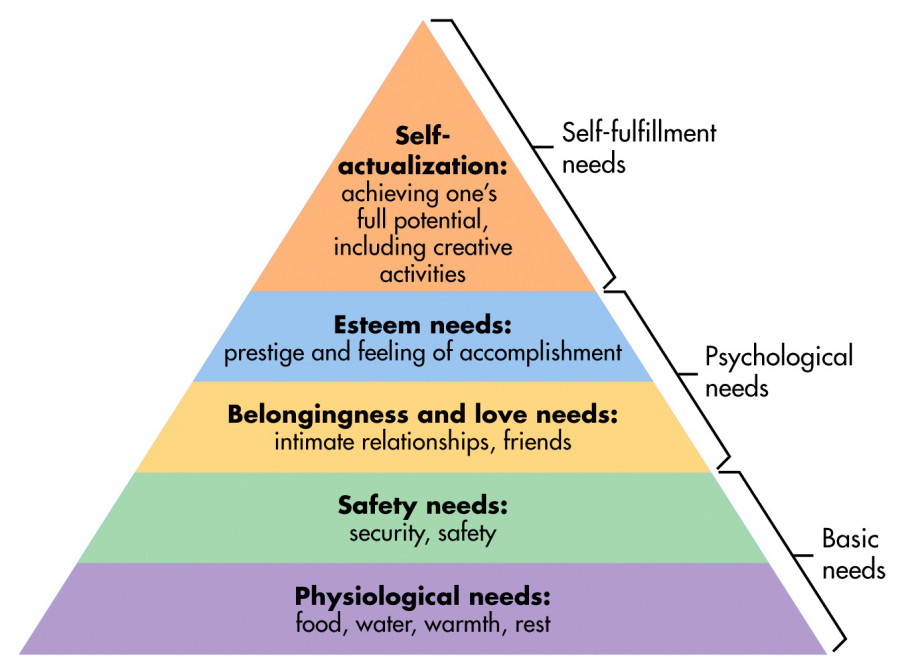Motivation & Emotion
1/21
Earn XP
Description and Tags
Name | Mastery | Learn | Test | Matching | Spaced |
|---|
No study sessions yet.
22 Terms
Motivation
A need or desire that energizes and directs behavior
Instinct
A complex behavior that is rigidly patterned throughout a species and is unlearned (e.g., imprinting in birds or the return of salmon to their birthplace to spawn). Reflexes in human infants are too simple to be considered instincts
Drive - Reduction Theory
The idea that a physiological NEED creates an aroused state of tension (DRIVE) that motivates an organism to satisfy that need
NEED (Food or Water) → DRIVE (Hunger or Thirst) → DRIVE-REDUCING BEHAVIORS (Eating or Drinking)
Based on the concept of Homeostasis: a tendency to maintain a balanced or constant internal state; the regulation of any aspect of body chemistry, such as blood glucose, around a particular level
Arousal Theory
Rather that reducing a physiological need or tension state, some motivated behaviors increase arousal. Curiosity-driven behaviors, for example, suggest that too little as well as too much stimulation can motivate people to seek an optimum level of arousal
Incentive Theory
Theory that even if a need or drive is not originally present, positive or negative environmental stimuli may motivate behavior (e.g., after finishing a big meal, and feeling totally satisfied, we may become hungry again if we see or smell a delicious dessert)
Hierarchy of Needs
Maslow's pyramid of human needs, beginning at the base with physiological needs that must first be satisfied before higher-level needs become active

Optimal Arousal Theory
Claims the level of arousal for optimal performance varies with the task – some motivated behaviors actually increase arousal. Unlike drive-reduction theories which say that we do something to eliminate arousal, this theory claims we do things to increase arousal
Yerkes - Dodson Law
Usually perform most activities best when moderately aroused
We perform difficult or newly learned tasks better at lower levels of arousal and we tend to perform easy or well-learned tasks at a higher level of arousal
Emotion
Response that includes physiological arousal, expressive behavior and conscious thoughts
Theories of Emotion: James - Lange Theory
Stimulus → Snake
Physiological reaction occurs FIRST such as heart rate, pulse, or breathing increases
Emotion follows – fear
This claims that there is a unique set of physiological symptoms for each emotion. Physiological behavior CAUSES emotion. So, if we smile, we start to feel happy
Theories of Emotion: Cannon - Bard Theory
Stimulus → Snake
Thalamus sends message to the cortex and internal organs SIMULTANEOUSLY
Experience emotion (fear) and physiological behavior (heart pounding) at the same time
Doesn’t believe the body’s responses are distinct enough to differentiate between love and anger and fear. They all have similar physiology
Theories of Emotion: Cognition Theory (Schachter Two - Factor Theory)
Stimulus → Snake
Physiological response occurs – heart pounding
Mind interprets the experience – Look there is a snake! OMG!
Emotion is labeled – I must be feeling fear!
The same physical response (heart pounding) could happen later in the day. But, the mind might interpret that differently (Wow, a cute guy is looking at me). The emotion is then labeled (I’m in love!)
Criticism
Some physiological responses to a stimulus can trigger emotion before the brain has a chance to interpret them as simple emotions such as fear, dislike, disgust
Robert Zajonc
We have an emotional reaction BEFORE we interpret a situation. Some (fear) responses happen without conscious appraisal
Richard Lazarus
Our brain processes vast amounts of information without our awareness and SOME emotional responses do not require conscious thinking. (Similar to Zajonc)
HOWEVER…there is still cognitive appraisal happening, we just might not be aware of it. This still makes it a cognitive process (Similar to the Two-Factor theory)
Lie Detection
Polygraph is the machine used to detect lies by measuring several physiological responses (perspiration, heart rate, breathing) Assumes that these responses will RISE when the person lies due to emotion. NOT VERY ACCURATE
Facial Expressions - Ekman
Women are better than men at reading emotion in body language
Six emotions are expressed the same way in ALL cultures
Happy, Sad, Surprise, Anger, Disgust, Fear
It is believed this is the result of evolution/not learning. The facial muscles serve an important purpose. (brows drop when angry to protect eyes from a punch)
Display Rules
Socially learned norms within a culture that dictate how emotions should be expressed
Facial Feedback Effect
Smiling makes you feel happy!
When people smile, the facial muscles regulate the flow of air and temperature that can create a good feeling. When we imitate others’ facial expressions we also feel the way they feel.
Experiencing Emotion: Fear
Adaptive response preparing our bodies to flee danger
Acquired through classical conditioning or observational learning
May have a biological predisposition in how the amygdala responds
Experiencing Emotion: Anger
Caused by annoyances, odors, temperatures, aches and pains
How to channel anger appropriately? Exercise, play music, talking
Expressing anger usually leads to more anger – non cathartic
Experiencing Emotion: Happiness
Adaptation-Level Principle – we adapt to levels of a stimulus and need something even better to make us happy
Relative-Deprivation Principle – sense that we are worse off than others with whom we compare ourselves. We look to those who are more successful/happy/wealthy than ourselves and feel envy rather than compare ourselves to those worse off and feel happy
Predictors of Happiness - High self-esteem, outgoing, friends, work, faith, sleep, exercise